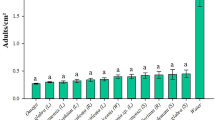Abstract
The present study was carried out to investigate the biocontrol potentiality of active ingredient isolated from ethyl acetate extract of mature leaves of Solanum nigrum L. (Solanaceae) against the larval form of Culex quinquefasciatus Say. Mortality rate at a concentration of 25 mg/L of the active compound was highest (P < 0.05) amongst all tested concentrations. Result of log-probit analysis (at 95 % confidence level) revealed that LC50 and LC90 values are inversely proportional to exposure period of bioassay. A clear dose-dependent mortality was observed, as the rate of mortality (Y) was positively correlated with the concentrations of the compound (X); having regression coefficient value close to 1. The compound was found to be ecofriendly as it did not show any adverse effect to the studied nontarget organisms. Chemical characterization of the active ingredient was also carried out by infrared spectroscopic analysis (IR), mass analyses (GC-MS) and carbon-hydrogen-nitrogen-sulphur analyses (CHNS), that revealed the presence of a glucosinolate compound [1-thio-ß-d-glucopyranose-1-[(R)-3-hydroxy-2-ethyl-N-hydroxysulfonyloxy propanimidate] having the molecular formula of C11H21NO10S2.



Similar content being viewed by others
References
Abbott WS (1925) A method of computing the effectiveness of an insecticide. J Eco Entomol 18:265–267
Anees AM (2008) Larvicidal activity of Ocimum sanctum Linn. (Labiatae) against Aedes aegypti (L.) and Culex quinquefasciatus (Say). Parasitol Res 101:1451–1453
Ansari MA, Vasudevan P, Tandon M, Razdan RK (2000) Larvicidal and mosquito repellent action of peppermint (Mentha piperita) oil. Biores Tech 71(3):267–271
Cai XF, Chin YW, Oh SR, Kwon OK, Ahn KS, Lee HK (2010) Antiinflammatory constituents from Solanum nigrum. Bull Koran Chem Society 31(1):199–201
Campbell FL, Sullivan WW, Smith LN (1993) The relative toxicity of nicotine, anabasine, methyl anabasine and lupine for Culicine mosquito larvae. J Econ Entomol 26:500
Chadha KL, Gupta R (1995) Medicinal and aromatic plants, vol 11. Advances in horticulture. Malhotra Publishing House, New Delhi, p 932
Chatterjee C, Banerjee TC (2007) Temporal changes in environmental characteristics and diversity of net phytoplankton in a fresh water lake. Turk J Bot 31:287–296
Edmonds JM, Chweya JA (1977) Blake nightshades Solanum nigrum L. and related species. International Plant Genetic Resources Institute, Rome, Italy
Ghosh A, Chowdhury N, Chandra G (2012) Plant extracts as potential mosquito larvicide—a review. J Med Res 135:581–598
ICMR Bulletin (2002) Prospects of elimination of lymphatic filariasis in India. ICMR Bull 32: 5–6
Jacobs-Lorena M, James AA (2002) Genetic modification of insects of medical importance: past, present and future. Report of the Scientific Working Group on Insect Vectors and Human Health. TDR/SWG/VEC/03. 1: 68–73
Kamaraj C, Rahuman AA (2010) Larvicidal and adulticidal potential of medicinal plant extracts from south India against vectors. Asian Pac J Trop Med 3:948–953
Kamaraj C, Rahuman AA, Bagavan A, Abduz Zahir A, Elango G, Kandan P (2010) Larvicidal efficacy of medicinal plant extracts against Anopheles stephensi and Culex quinquefasciatus (Diptera: Culicidae). Trop Biomed 27:211–219
Kishore N, Mishra BB, Tiwari VK, Tripathi V (2011) A review on natural products with mosquitosidal potentials. Tiwari VK (ed) Opportunity, Challenge and Scope of Natural Products in Medicinal Chemistry. Research Signpost, Kerala, pp 335–365
Macedo ME, Consoli RA, Grandi TS, Anjosdos AM, de Oliveira AB, Mendes NM, Queiroz RO, Zani CL (1997) Screening of Asteraceae (Compositae) plant extracts for larvicidal activity against Aedes fluviatilis (Diptera: Culicidae). Mem Inst Oswaldo Cruz 92:565–568
Matasyoh JC, Wathuta EM, Kairuki ST, Chepkorir R, Kavulani J (2008) Aloe plant extracts as alternative larvicides for mosquito control. Afr J Biotech 7:912–915
Michael E, Bundy DAP, Grenfel BT (1996) Re-assessing the global prevalence and distribution of lymphatic filariasis. Parasito 122:409
Rawani A, Mallick HK, Ghosh A, Chandra G (2009) Larvicidal activities of three plants against filarial vector Culex quinquefasciatus Say (Diptera: Culicidae). Parasitol Res 105:1411–1417. doi:10.1007/s00436-009-1573-z
Rawani A, Ghosh A, Chandra G (2010) Mosquito larvicidal activities of Solanum nigrum L. leaf extract against Culex quinquefasciatus Say. Parasitol Res 107:1235–1240
Saleem MTS, Chetty CM, Ramkanth S, Rajan VST, Kumar KM, Gauthaman K (2010) Hepatoprotective herbs—a review. J Res Pharmaceu Sc 1(pt 1):1–5
Senthil Nathan S, Hisham A, Jayakumar G (2008) Larvicidal and growth inhibition of the malaria vector Anopheles stephensi by triterpenes from Dysoxylum malabaricum and Dysoxylum beddomei. Fitoterapia 79:106–111
Shaalan EAS, Canyonb D, Younesc MWF, Abdel-Wahaba H, Mansoura AH (2005) A review of botanical phytochemicals with mosquitocidal potential. Environ Int 31:1149–1166
Sukumar K, Perich MJ, Boobar LR (1991) Botanical derivatives in mosquito control—a review. J Am Mos Cont Asso 7:210–237
Suwannee P, Amara N, Maleeya K, Usavadee T (2006) Evaluations of larvicidal activity of medicinal plant extracts to Aedes aegypti (Diptera: Culicidae) and other effects on a non target fish. Insect Sci 13:179–188
Tsao R, Reuber M, Johnson L, Joel RC (1996) Insecticidal toxicities of glucosinolate containing extracts from Crambe seeds. Agric Entomol 13(2):109–120
WHO (1970) Insecticide resistance and vector control. XVII Report of WHO Expert Committee on Insecticides. World Health Organization Technical Report Series. 443: 279
WHO (2005) Guidelines for laboratory and field testing of mosquito larvicides. Geneva: World Health Organization, WHO / CDS / WHOPES / GCDP. p 13
Acknowledgments
The authors would like to acknowledge/thank the help of Dr. Ambarish Mukherjee, professor of botany in the University of Burdwan, for the identification of the plant. The financial support provided by the DST, New Delhi, India (D.O. NO.SR/SO/HS/84/2007 dated 08/02/08) is thankfully acknowledged. The financial support provided by the University Grants Commission [PSW 001/11-12(ERO-3811)] to Dr. Anupam Ghosh is also thankfully acknowledged.
Conflict of interest
There is no conflict of interest.
Author information
Authors and Affiliations
Corresponding author
Rights and permissions
About this article
Cite this article
Rawani, A., Ghosh, A., Laskar, S. et al. Glucosinolate from leaf of Solanum nigrum L. (Solanaceae) as a new mosquito larvicide. Parasitol Res 113, 4423–4430 (2014). https://doi.org/10.1007/s00436-014-4120-5
Received:
Accepted:
Published:
Issue Date:
DOI: https://doi.org/10.1007/s00436-014-4120-5




